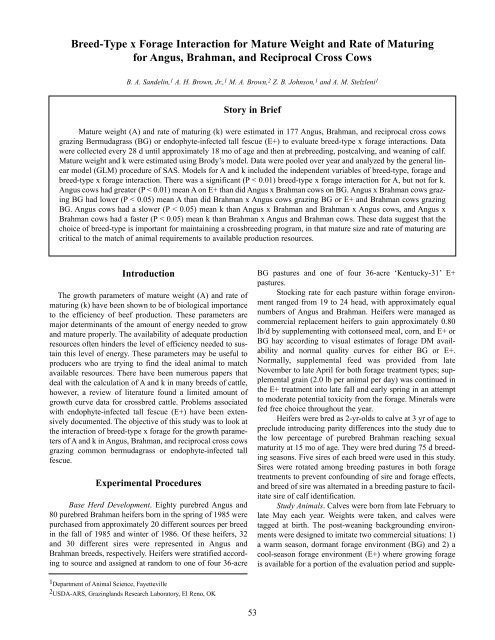Arkansas - Agricultural Communication Services - University of ...
Arkansas - Agricultural Communication Services - University of ...
Arkansas - Agricultural Communication Services - University of ...
You also want an ePaper? Increase the reach of your titles
YUMPU automatically turns print PDFs into web optimized ePapers that Google loves.
Breed-Type x Forage Interaction for Mature Weight and Rate <strong>of</strong> Maturing<br />
for Angus, Brahman, and Reciprocal Cross Cows<br />
B. A. Sandelin, 1 A. H. Brown, Jr., 1 M. A. Brown, 2 Z. B. Johnson, 1 and A. M. Stelzleni 1<br />
Story in Brief<br />
Mature weight (A) and rate <strong>of</strong> maturing (k) were estimated in 177 Angus, Brahman, and reciprocal cross cows<br />
grazing Bermudagrass (BG) or endophyte-infected tall fescue (E+) to evaluate breed-type x forage interactions. Data<br />
were collected every 28 d until approximately 18 mo <strong>of</strong> age and then at prebreeding, postcalving, and weaning <strong>of</strong> calf.<br />
Mature weight and k were estimated using Brody’s model. Data were pooled over year and analyzed by the general linear<br />
model (GLM) procedure <strong>of</strong> SAS. Models for A and k included the independent variables <strong>of</strong> breed-type, forage and<br />
breed-type x forage interaction. There was a significant (P < 0.01) breed-type x forage interaction for A, but not for k.<br />
Angus cows had greater (P < 0.01) mean A on E+ than did Angus x Brahman cows on BG. Angus x Brahman cows grazing<br />
BG had lower (P < 0.05) mean A than did Brahman x Angus cows grazing BG or E+ and Brahman cows grazing<br />
BG. Angus cows had a slower (P < 0.05) mean k than Angus x Brahman and Brahman x Angus cows, and Angus x<br />
Brahman cows had a faster (P < 0.05) mean k than Brahman x Angus and Brahman cows. These data suggest that the<br />
choice <strong>of</strong> breed-type is important for maintaining a crossbreeding program, in that mature size and rate <strong>of</strong> maturing are<br />
critical to the match <strong>of</strong> animal requirements to available production resources.<br />
Introduction<br />
The growth parameters <strong>of</strong> mature weight (A) and rate <strong>of</strong><br />
maturing (k) have been shown to be <strong>of</strong> biological importance<br />
to the efficiency <strong>of</strong> beef production. These parameters are<br />
major determinants <strong>of</strong> the amount <strong>of</strong> energy needed to grow<br />
and mature properly. The availability <strong>of</strong> adequate production<br />
resources <strong>of</strong>ten hinders the level <strong>of</strong> efficiency needed to sustain<br />
this level <strong>of</strong> energy. These parameters may be useful to<br />
producers who are trying to find the ideal animal to match<br />
available resources. There have been numerous papers that<br />
deal with the calculation <strong>of</strong> A and k in many breeds <strong>of</strong> cattle,<br />
however, a review <strong>of</strong> literature found a limited amount <strong>of</strong><br />
growth curve data for crossbred cattle. Problems associated<br />
with endophyte-infected tall fescue (E+) have been extensively<br />
documented. The objective <strong>of</strong> this study was to look at<br />
the interaction <strong>of</strong> breed-type x forage for the growth parameters<br />
<strong>of</strong> A and k in Angus, Brahman, and reciprocal cross cows<br />
grazing common bermudagrass or endophyte-infected tall<br />
fescue.<br />
Experimental Procedures<br />
Base Herd Development. Eighty purebred Angus and<br />
80 purebred Brahman heifers born in the spring <strong>of</strong> 1985 were<br />
purchased from approximately 20 different sources per breed<br />
in the fall <strong>of</strong> 1985 and winter <strong>of</strong> 1986. Of these heifers, 32<br />
and 30 different sires were represented in Angus and<br />
Brahman breeds, respectively. Heifers were stratified according<br />
to source and assigned at random to one <strong>of</strong> four 36-acre<br />
BG pastures and one <strong>of</strong> four 36-acre ‘Kentucky-31’ E+<br />
pastures.<br />
Stocking rate for each pasture within forage environment<br />
ranged from 19 to 24 head, with approximately equal<br />
numbers <strong>of</strong> Angus and Brahman. Heifers were managed as<br />
commercial replacement heifers to gain approximately 0.80<br />
lb/d by supplementing with cottonseed meal, corn, and E+ or<br />
BG hay according to visual estimates <strong>of</strong> forage DM availability<br />
and normal quality curves for either BG or E+.<br />
Normally, supplemental feed was provided from late<br />
November to late April for both forage treatment types; supplemental<br />
grain (2.0 lb per animal per day) was continued in<br />
the E+ treatment into late fall and early spring in an attempt<br />
to moderate potential toxicity from the forage. Minerals were<br />
fed free choice throughout the year.<br />
Heifers were bred as 2-yr-olds to calve at 3 yr <strong>of</strong> age to<br />
preclude introducing parity differences into the study due to<br />
the low percentage <strong>of</strong> purebred Brahman reaching sexual<br />
maturity at 15 mo <strong>of</strong> age. They were bred during 75 d breeding<br />
seasons. Five sires <strong>of</strong> each breed were used in this study.<br />
Sires were rotated among breeding pastures in both forage<br />
treatments to prevent confounding <strong>of</strong> sire and forage effects,<br />
and breed <strong>of</strong> sire was alternated in a breeding pasture to facilitate<br />
sire <strong>of</strong> calf identification.<br />
Study Animals. Calves were born from late February to<br />
late May each year. Weights were taken, and calves were<br />
tagged at birth. The post-weaning backgrounding environments<br />
were designed to imitate two commercial situations: 1)<br />
a warm season, dormant forage environment (BG) and 2) a<br />
cool-season forage environment (E+) where growing forage<br />
is available for a portion <strong>of</strong> the evaluation period and supple-<br />
1 Department <strong>of</strong> Animal Science, Fayetteville<br />
2 USDA-ARS, Grazinglands Research Laboratory, El Reno, OK<br />
53

















